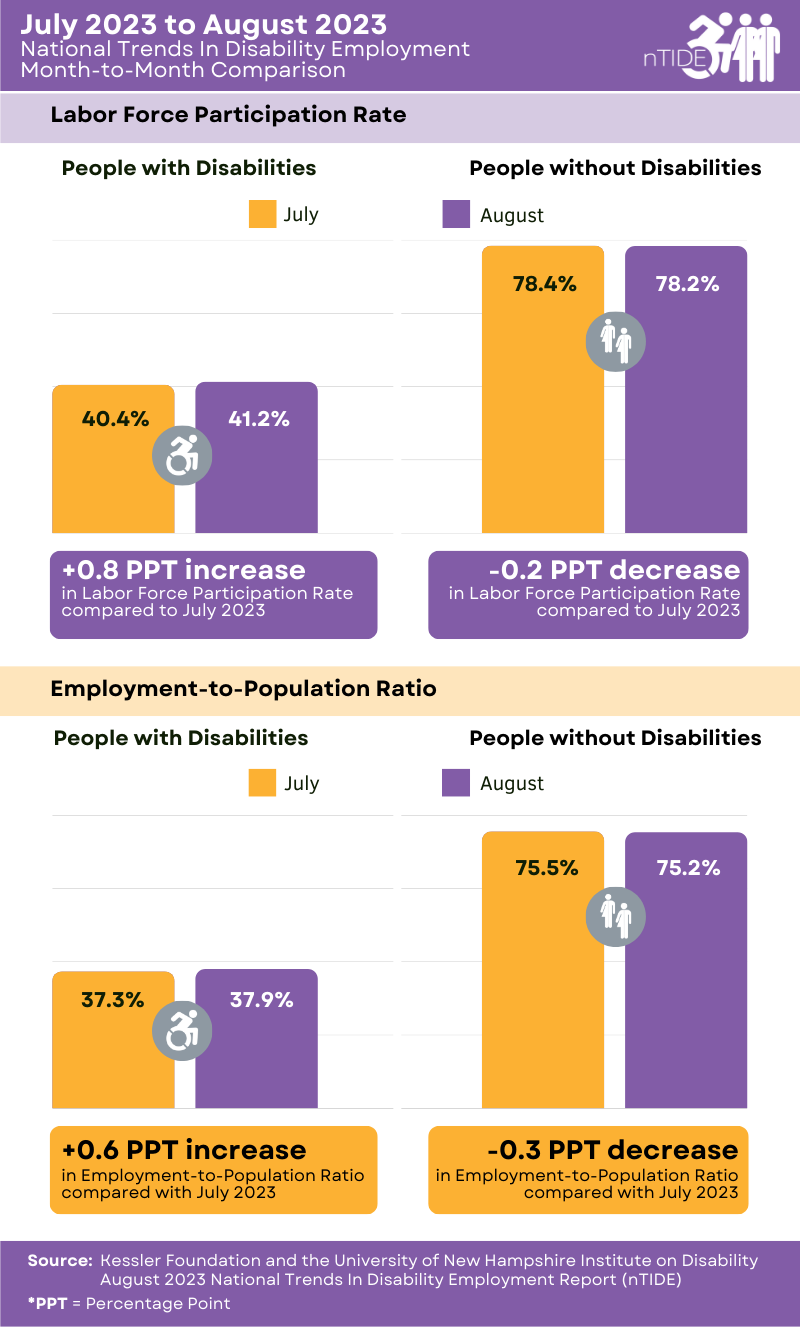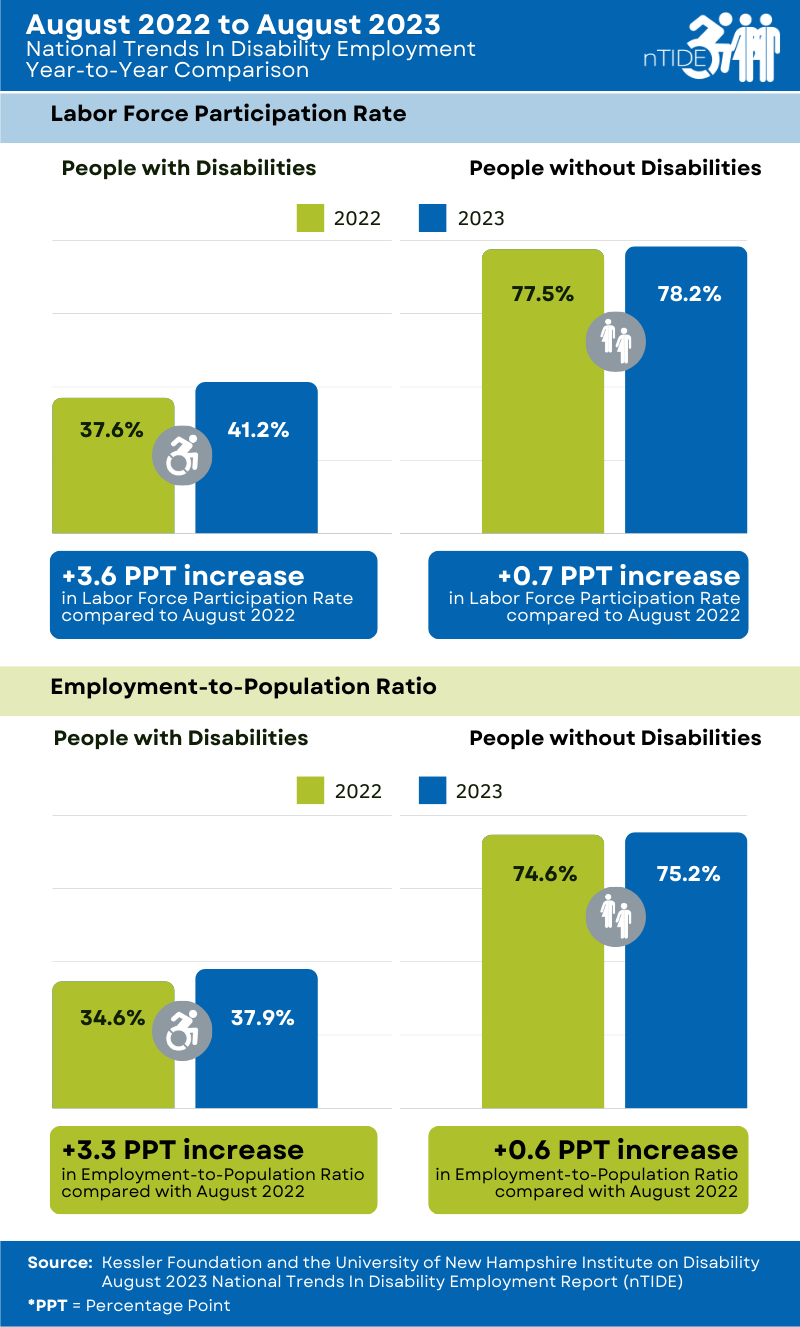National Trends in Disability Employment (nTIDE) – Issued semi-monthly by Kessler Foundation and the University of New Hampshire
East Hanover, NJ – September 1, 2023 – Labor Day weekend brings more good news for people with disabilities, with record-breaking highs for labor force participation and employment-to-population ratio, according to today’s National Trends in Disability Employment – semi-monthly update (nTIDE), issued by Kessler Foundation and the University of New Hampshire’s Institute on Disability (UNH-IOD). In comparison, both indicators declined slightly for people without disabilities.

Month-to-Month nTIDE Numbers (comparing July 2023 to August 2023)
Based on data from the U.S. Bureau of Labor Statistics (BLS) Jobs Report released today, the employment-to-population ratio for people with disabilities (ages 16-64) increased from 37.3 percent in July 2023 to 37.9 percent in August 2023 (up 1.6 percent or 0.6 percentage points). For people without disabilities (ages 16-64), the employment-to-population ratio decreased from 75.5 percent in July 2023 to 75.2 percent in August 2023 (down 0.4 percent or 0.3 percentage points). The employment-to-population ratio, a key indicator, reflects the percentage of people who are working relative to the total population (the number of people working divided by the number of people in the total population multiplied by 100).
“The employment-to-population ratio for people with disabilities jumped to a new all-time high contrasting sharply with people without disabilities whose ratio dropped slightly,” said John O’Neill, PhD, director of the Center for Employment and Disability Research at Kessler Foundation. “Employment opportunities remain plentiful and people with disabilities are rising to the occasion and filling these positions, which may be contributing to this trend,” he added.
The labor force participation rate for people with disabilities (ages 16-64) increased from 40.4 percent in July 2023 to 41.2 percent in August 2023 (up 2 percent or 0.8 percentage points). For people without disabilities (ages 16-64), the labor force participation rate decreased from 78.4 percent in July 2023 to 78.2 percent in August 2023 (down 0.3 percent or 0.2 percentage points). The labor force participation rate reflects the percentage of people who are in the labor force (working, on temporary layoff (on furlough), or actively looking for work in the last four weeks) relative to the total population (the number of people in the labor force divided by the number of people in the total population multiplied by 100).
“The continued rise in labor force participation reinforces long-held views that people with disabilities are striving to work,” said Andrew Houtenville, PhD, professor of economics and research director of the UNH-IOD, “which was a major finding from our 2015 Kessler Foundation National Employment and Disability Survey. To explore possible reasons behind these record-breaking trends, join our mid-month Deeper Dive webinars to get answers to your questions from the nTIDE team,” he recommended. (See link below.)

Year-to-Year nTIDE Numbers (comparing August 2022 to August 2023)
Compared to the same month last year, the labor force participation rate for people with disabilities (ages 16-64) increased from 37.6 percent in August 2022 to 41.2 percent in August 2023 (up 9.6 percent or 3.6 percentage points). For people without disabilities (ages 16-64), the labor force participation rate also increased from 77.5 percent in August 2022 to 78.2 percent in August 2023 (up 0.9 percent or 0.7 percentage points).
The employment-to-population ratio for working-age people with disabilities increased from 34.6 percent in August 2022 to 37.9 percent in August 2023 (up 9.5 percent or 3.3 percentage points). For working-age people without disabilities, the employment-to-population ratio also increased from 74.6 percent in August 2022 to 75.2 percent in August 2023 (up 0.8 percent or 0.6 percentage points).
In August, among workers ages 16-64, the 6,533,000 workers with disabilities represented 4.3 percent of the total 150,594,000 workers in the U.S.
Ask Questions about Disability and Employment
Each nTIDE release is followed by an nTIDE Lunch & Learn online webinar. This live broadcast, hosted via Zoom Webinar, offers attendees Q&A on the latest nTIDE findings, provides news and updates from the field and features invited panelists who discuss current disability-related findings and events.
On September 1, 2023, at 12:00 pm Eastern, guest presenter Rylin Rodgers , Disability Policy Advisor at Microsoft Accessibility, joins Drs. O’Neill and Houtenville. Join our free Lunch & Learn live or visit the nTIDE archives at: . Also, register now for our mid-month Deeper Dive into employment trends at nTIDE Deeper Dive – 9/22/2023.
NOTE: The statistics in the nTIDE are based on BLS numbers but are not identical. They are customized by UNH to combine the statistics for men and women of working age (16- 64). nTIDE is funded by Kessler Foundation and was initially funded by grants from the National Institute on Disability, Independent Living and Rehabilitation Research (NIDILRR) (90RT5037).
About the Institute on Disability at the University of New Hampshire
The Institute on Disability (IOD) at the University of New Hampshire (UNH) was established in 1987 to provide a university-based focus for the improvement of knowledge, policies, and practices related to the lives of persons with disabilities and their families. For information on the NIDILRR-funded Research and Training Center on Disability Statistics, visit ResearchOnDisability.org.
About Kessler Foundation
Kessler Foundation, a major nonprofit organization in the field of disability, is a global leader in rehabilitation research. Our scientists seek to improve cognition, mobility, and long-term outcomes, including employment, for adults and children with neurological and developmental disabilities of the brain and spinal cord including traumatic brain injury, spinal cord injury, stroke, multiple sclerosis, and autism. Kessler Foundation also leads the nation in funding innovative programs that expand opportunities for employment for people with disabilities. For more information, visit KesslerFoundation.org.